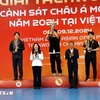Authorities of northern Phu Tho province are working to bring Xoan singing out of the list of Intangible Cultural Heritage in Need of Urgent Safeguarding as soon as in 2016, Ha Ke San, Vice Chairman of the provincial People's Committee, has said.
Measures being taken include carrying out research, teaching, training and collection, as well as compiling information about the area's heritage, San said.
Ancient Xoan songs, which had been transmitted orally, will be collected, recorded and publicised to serve as training and research materials, he added.
There is a plan involving the restoration, preservation and practice of the singing in four original Xoan communities in Phu Duc, Kim Doi, Thet and An Thai, he added.
Various classes teaching Xoan singing have been held for those who are interested in the singing genre, including teenagers, under the guidance of 15 masters.
Renowned singer Nguyen Thi Lich said the teaching of Xoan singing for the next generations is crucial to remove the genre from the list of Cultural Heritage In Need of Urgent Safeguarding and promote its values ever then.
The training of the next generations of Xoan singers has been defined as top priority in the project to preserve the genre and promote its value that was approved by the Prime Minister.
According to the provincial official, the promotion of the Xoan heritage of the Hung Kings worship religion, which was recognised as one of the world's intangible heritage in 2012, should be connected to the development of tourism through performances of xoan singing troupes from 2016 to 2020.
Xoan singing, or hat xoan, is a genre of Vietnamese folk music performed in the spring, during the first two months of the Lunar New Year or Tet in the northern province of Phu Tho.
Traditionally singers from Xoan guilds performed songs in sacred spaces such as temples, shrines and communal houses for the spring festivals. There are three forms of Xoan singing: worship singing for the Hung Kings and village guardian spirits; ritual singing for good crops, health and luck; and festival singing where villagers alternate made and female voices in a form of courtship.
Each Xoan music guild is headed by a leader, referred to as the Trum; male instrumentalists are called Kep and female singer, Dao. Xoan singing is accompanies by dancing and musical instruments such as clappers and a variety of drums.
The music has a spare structure with few ornamental notes and simple rhythms and Xoan is characterised by a modulation between singers and instrumentalists at the perfect fourth interval.
Knowledge, customs and techniques for singing, dancing and playing drum and clappers are traditionally transmitted orally by the guild leader. However, the majority of bearers are now over 60 years old and the number of people who appreciate Xoan singing have decreased, particularly among the young generations.-VNA
Measures being taken include carrying out research, teaching, training and collection, as well as compiling information about the area's heritage, San said.
Ancient Xoan songs, which had been transmitted orally, will be collected, recorded and publicised to serve as training and research materials, he added.
There is a plan involving the restoration, preservation and practice of the singing in four original Xoan communities in Phu Duc, Kim Doi, Thet and An Thai, he added.
Various classes teaching Xoan singing have been held for those who are interested in the singing genre, including teenagers, under the guidance of 15 masters.
Renowned singer Nguyen Thi Lich said the teaching of Xoan singing for the next generations is crucial to remove the genre from the list of Cultural Heritage In Need of Urgent Safeguarding and promote its values ever then.
The training of the next generations of Xoan singers has been defined as top priority in the project to preserve the genre and promote its value that was approved by the Prime Minister.
According to the provincial official, the promotion of the Xoan heritage of the Hung Kings worship religion, which was recognised as one of the world's intangible heritage in 2012, should be connected to the development of tourism through performances of xoan singing troupes from 2016 to 2020.
Xoan singing, or hat xoan, is a genre of Vietnamese folk music performed in the spring, during the first two months of the Lunar New Year or Tet in the northern province of Phu Tho.
Traditionally singers from Xoan guilds performed songs in sacred spaces such as temples, shrines and communal houses for the spring festivals. There are three forms of Xoan singing: worship singing for the Hung Kings and village guardian spirits; ritual singing for good crops, health and luck; and festival singing where villagers alternate made and female voices in a form of courtship.
Each Xoan music guild is headed by a leader, referred to as the Trum; male instrumentalists are called Kep and female singer, Dao. Xoan singing is accompanies by dancing and musical instruments such as clappers and a variety of drums.
The music has a spare structure with few ornamental notes and simple rhythms and Xoan is characterised by a modulation between singers and instrumentalists at the perfect fourth interval.
Knowledge, customs and techniques for singing, dancing and playing drum and clappers are traditionally transmitted orally by the guild leader. However, the majority of bearers are now over 60 years old and the number of people who appreciate Xoan singing have decreased, particularly among the young generations.-VNA



















